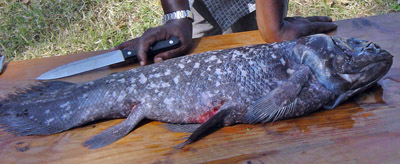
July 16, 2007

Small coelacanth from Tanzania caught in February 2007; it is not the one discussed below. Photo courtesy dinofish.
The known range of the coelacanth is expanded with this new discovery, and hope remains high that the “living fossil” fish may exist in some surprising locations around the world.
Zanzibar, Tanzania – Fishermen have caught a rare and endangered fish, the coelacanth, off the coast of the Indian Ocean archipelago of Zanzibar, a researcher said on Monday [July 16, 2007].
The find makes Zanzibar the third place in Tanzania where fishermen have caught the coelacanth, a heavy-bodied, many-finned fish with a three-lobed tail that was thought extinct until it was caught in 1938 off the coast of South Africa. Since then two types of coelacanth have been caught in five other countries: Comoros, Indonesia, Kenya, Madagascar and Mozambique, according to African Coelacanth Ecosystem Program.
“Fishermen informed us that they caught a strange fish in their nets. We rushed to Nungwi (the northern reaches of Zanzibar) to find it’s a coelacanth, a rare fish thought to have become extinct when it disappeared from fossil records 80 million years ago,” said Nariman Jiddawi of the Institute of Marine Sciences, which is part of the University of Dar es Salaam in Tanzania’s commercial capital.
Trade in the coelacanth is banned under the Convention on International Trade in Endangered Species of Wild Fauna and Flora.
“Zanzibar will join a list of sites of having the rare fish caught in its own waters,” said Jiddawi, adding the catch weighed 59.5 pounds and measured 4.4 feet.
Four fishermen caught the fish on Saturday [July 14, 2007], Jiddawi said.
Mussa Aboud Jume, director of fisheries in Zanzibar, said that the coelacanth will be preserved and put on display at the Zanzibar Museum.
A statement of the Institute of Marine Sciences said that 35 coelacanths have been caught since September 2003 in Mtwara, a southern region of Tanzania, and mostly along the coast of Tanga in Tanzania’s north.
Coelacanths are the only living animals to have a fully functional intercranial joint, a division separating the ear and brain from the nasal organs and eye, according to an Institute of Marine Sciences statement.by Ali Sultan, AP writer, “Tanzania fishermen catch endangered fish,”, July 16, 2007, Associated Press.
About Loren Coleman
Loren Coleman is one of the world’s leading cryptozoologists, some say “the” leading living cryptozoologist. Certainly, he is acknowledged as the current living American researcher and writer who has most popularized cryptozoology in the late 20th and early 21st centuries.
Starting his fieldwork and investigations in 1960, after traveling and trekking extensively in pursuit of cryptozoological mysteries, Coleman began writing to share his experiences in 1969. An honorary member of Ivan T. Sanderson’s Society for the Investigation of the Unexplained in the 1970s, Coleman has been bestowed with similar honorary memberships of the North Idaho College Cryptozoology Club in 1983, and in subsequent years, that of the British Columbia Scientific Cryptozoology Club, CryptoSafari International, and other international organizations. He was also a Life Member and Benefactor of the International Society of Cryptozoology (now-defunct).
Loren Coleman’s daily blog, as a member of the Cryptomundo Team, served as an ongoing avenue of communication for the ever-growing body of cryptozoo news from 2005 through 2013. He returned as an infrequent contributor beginning Halloween week of 2015.
Coleman is the founder in 2003, and current director of the International Cryptozoology Museum in Portland, Maine.
Filed under Breaking News, Cryptotourism, CryptoZoo News, Cryptozoologists, Cryptozoology, Extinct, Fossil Finds, Living Dinosaurs, Museums, New Species